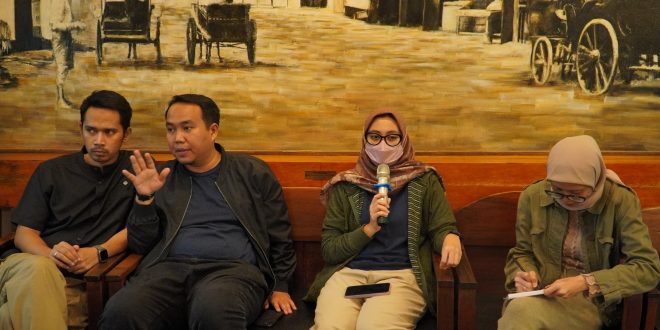The General Election Commission (KPU) determined the results of the 2024 elections on March 20, but there is still disproportionality in the seats in the election results. There were at least 17.3 million wasted votes from 18 political parties participating in the election; this was because only 8 parties passed the parliamentary threshold of 4 percent. The Association for Elections and Democracy (Perludem) believes that the parliamentary threshold figures must be readjusted so that not many votes are wasted in the upcoming 2029 elections.
“The proportional legislative election system is a balance between the party’s seat acquisition and the votes it has.” So simply put, if the party gets 4 percent, then if it is converted into seats, it must be equivalent to 4 percent at the parliamentary level,” said the researcher, Heroik Pratama, in a discussion entitled “Proportionality and the Party System from the 2024 Election Results” in Menteng, Central Jakarta (24/3).
The parliamentary threshold is the minimum requirement for a political party to obtain votes to be included in determining seats in the People’s Representative Council (DPR). In Indonesia, the parliamentary threshold was implemented in the 2009 elections with a figure of 2.5 percent; of 38 political parties, only 9 parties passed the parliamentary threshold. In the 2014 election, this figure was increased to 3.5 percent; as a result, out of 12 parties, only 10 passed, while in the 2019 election, with a threshold of 4 percent, out of 12 parties, only 9 met the threshold. With the same figures, the results of the 2024 election passed 8 parties out of 18 parties participating in the election.
According to Heroik, there are actually two types of threshold models, namely the legal threshold and the effective threshold. According to him, the legal threshold model as currently implemented in the system of determining the size has many political interests to prevent the entry of small parties into parliament. Meanwhile, according to Heroik, the effective threshold has the main aim of minimizing disproportionality in election results.
“The effective threshold formula proposed by Laakso Taagepera is 75 percent divided by the average size of the electoral district multiplied by the root of the number of parliamentary seats.” From this calculation, the effective parliamentary threshold is 1 percent,” explained Heroik.
Furthermore, the effective threshold can be applied nationally or based on electoral districts (dapil) at the provincial and district/city levels by calculating the size of the electoral district, the number of allocated seats, and the average of the electoral district. Heroik believes that under Article 414(1) of Law 7/2017, which states that the parliamentary threshold is 4%, there is no rational reason for determining this figure.
“This means that rational methodological options can be used by lawmakers in determining the size of the parliamentary threshold in the 2029 elections,” he said.
For information, the Constitutional Court (MK), through its decision in case 116/PUU-XXI/2023 submitted by Tulisdem, stated that the parliamentary threshold needs to be revised. In its decision, the Constitutional Court stated that improvements must be designed to be sustainable, maintain the proportionality of the proportional electoral system, remain in place to realize the simplification of political parties, involve all parties, and be made before the 2029 elections.
Projection of Conversion of 2024 Election Results
After the official announcement of the election results by the KPU, Eludem converted political parties’ vote tallies to measure each party’s seat tally. The method used is vote acquisition data, which is used based on the model D vote recapitulation form. Results are via the Recapitulation Information System (Sirekap).
“This is a projection of the conversion results before the KPU’s decision regarding the acquisition of seats for political parties is issued.” These results were before the Constitutional Court issued a decision regarding the General Election Results Dispute (PHPU),” explained Heroik.
Based on the Lucudem calculation, which was carried out using the Sainte-Lague method by dividing the party’s vote share by odd numbers and then sorting them from the highest number of votes according to the number of seats available, Heroik said that because there were three parties that were supposed to get seats but did not pass the parliamentary threshold, there was a shift in 12 PPP seats, 5 PSI seats, and 1 Perindo seat, which was finally obtained by another party that met the 4 percent parliamentary threshold.
As a result, of the total 580 DPR seats, the PDIP Party had the most seats, with 110 seats (19%). Followed by the Golkar Party with 102 seats (17.6%), Gerindra Party with 86 seats (14.8%), PKB with 68 seats (11.7%), Nasdem Party with 69 seats (11.9%), PKS with 53 seats (9.1%), Democratic Party with 44 seats (7.6%), and PAN with 48 seats (8.3%).
“PDIP won 110 seats out of 580, with 19% of the seats in the DPR. From there, we can see that the proportionality of election results is not proportional to the percentage of seats won. “In fact, if we use proportional legislative elections, the basic principle that must be fulfilled is proportionality between the votes obtained and the seats obtained by the party,” he explained.
Heroik emphasized that although the parliamentary threshold figures increase with each election, this has absolutely no impact on simplifying the party. This is because all parties with seats have a strong composition. That’s why, according to him, elected governments often invite other parties to form a majority of support in parliament.
“After the 2024 election, it is important to immediately revise the election law, one of which is reformulation towards the 2029 election,” he stressed.
Meanwhile, according to the Perudem Program Manager, Fadli Ramadhanil, the 2024 election was considered a failure because it was unable to simplify the party system. Even though the number of parties has decreased, DPR seats are spread across almost all political parties; in other words, all parties can influence DPR decision-making.
“You can imagine how ineffective it will be. “This will pose a huge risk to the process of decision-making and government,” he explained.
If that happens, according to Fadli, the decision-making process will be interlocked and shackled. He is concerned about the occurrence of “cow trading” politics (power sharing transactions between political elites) so that there is no control or supervision process in the DPR. According to him, efforts to build a new paradigm regarding the provisions of the electoral system must continue to be carried out by recalculating the threshold sizes and rearranging the size of electoral districts.
“In fact, continuously increasing the Parliamentary Threshold figure or maintaining it at 4 percent will result in an increase in the number of wasted votes that cannot be converted into seats,” explained Fadli. []
 Rumah Pemilu Indonesia Election Portal
Rumah Pemilu Indonesia Election Portal




